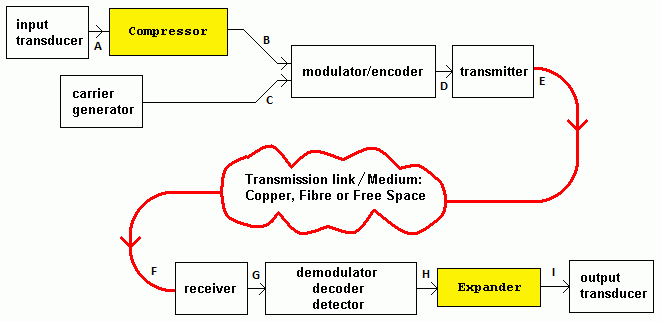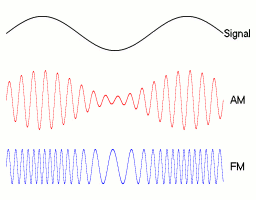
RANDOM PAGE
SITE SEARCH
LOG
IN
SIGN UP
HELP
To gain access to revision questions, please sign up and log in.
A2
aCommunication is the transfer of meaningful information from the sender to the receiver.

bSubsystem Links
- A: The information signal to be transmitted (Voice, music, DC to represent rudder position in Radio Control).
- B: Digitally compressed data. Analogue filtering and compression is possible too.
- C: The low power radio frequency carrier signal.
- D: The modulated carrier. The carrier has been modified in proportion to the signal to be transmitted.
- E: High power signal, usually radio, but light and ultrasound are common too.
- F: Attenuated signal. Energy is lost in the transmission medium. The received signal will most likely arrive with unwanted noise.
- G: Amplified signal.
- H: A low power copy of the original compressed signal.
- I: Ideally, an exact copy of the original information signal. There may be added noise, especially on analogue and AM systems.
The vast majority of communication systems include the following modules ...
cInput Transducer
- A device that converts a signal from nature into an electrical signal.
- For example a microphone for voice radio.
- Machine position sensors
- Robotic sensors
- Potentiometer used for position control
dCompressor
- Digital compression uses mathematical and statistical techniques (like making compressed ZIP files).
- Analogue compression modifies and filters the analogue signal to improve intelligibility.
eCarrier Generator
- The carrier is a radio frequency sine wave on a precise frequency. This is the radio signal that gets transmitted.
- The carrier is needed because the transducer signal is usually on too low a frequency to be transmitted.
- The carrier is produced by an oscillator circuit.
- The frequency is often controlled by a quartz crystal.
- Baseband Communication transmits data without a carrier by sending the original signals into the cables.
fModulator/Encoder
- The carrier wave is modified by the signal from the input transducer. Common modulation methods include AM and FM.
- Digital modulation encodes information onto the carrier my altering its amplitude and/or phase.

gTransmitter
- This is a power amplifier, used to boost the small signals above up to a useful power level for transmitting.
- Transmitter powers go from milliwatts for WiFi computer networks up to Megawatts for international radio broadcasting.
- Not all transmitters produce radio signals. A transmitter is needed to create the modulated light pulses for fibre optic links.
- Ultrasound is transmitted for imaging (foetus scan) and range finding used in top-end cars and by estate agents to measure room sizes.
hMedium
- Free space
- Fibre optic
- Copper cable
- Air
iReceiver
- This contains sensitive amplifiers to pick up the transmitted signal.
- This is necessary because the transmitted signal is attenuated (loses energy) in the medium and becomes much weaker.
jDemodulator / Decoder / Detector
- This retrieves the original signal from the modulated carrier.
- Ideally this can be done with no added noise or errors. Sadly this is rarely the case in real life.
kExpander
- Reverse any analogue or digital compression used in the transmitter.
lOutput Transducer
- Loudspeaker
- Machinery
- Robotic devices
- Servo in a radio control model
- Computer processor in a wireless computer network
mModulation Methods
Full details are elsewhere on this site.
- AM - Amplitude Modulation used on LF, MF and the HF radio bands. (Long, Medium and Short Wave).
- FM - Frequency Modulation used on the VHF bands.
- DAB - Digital Audio Broadcasting on VHF.
- PAM - Pulse Amplitude Modulation
- PWM - Pulse Width Modulation
- PPM - Pulse Position Modulation
- PCM - Pulse Code Modulation
reviseOmatic V3
Contacts, ©, Cookies, Data Protection and Disclaimers
Hosted at linode.com, London



